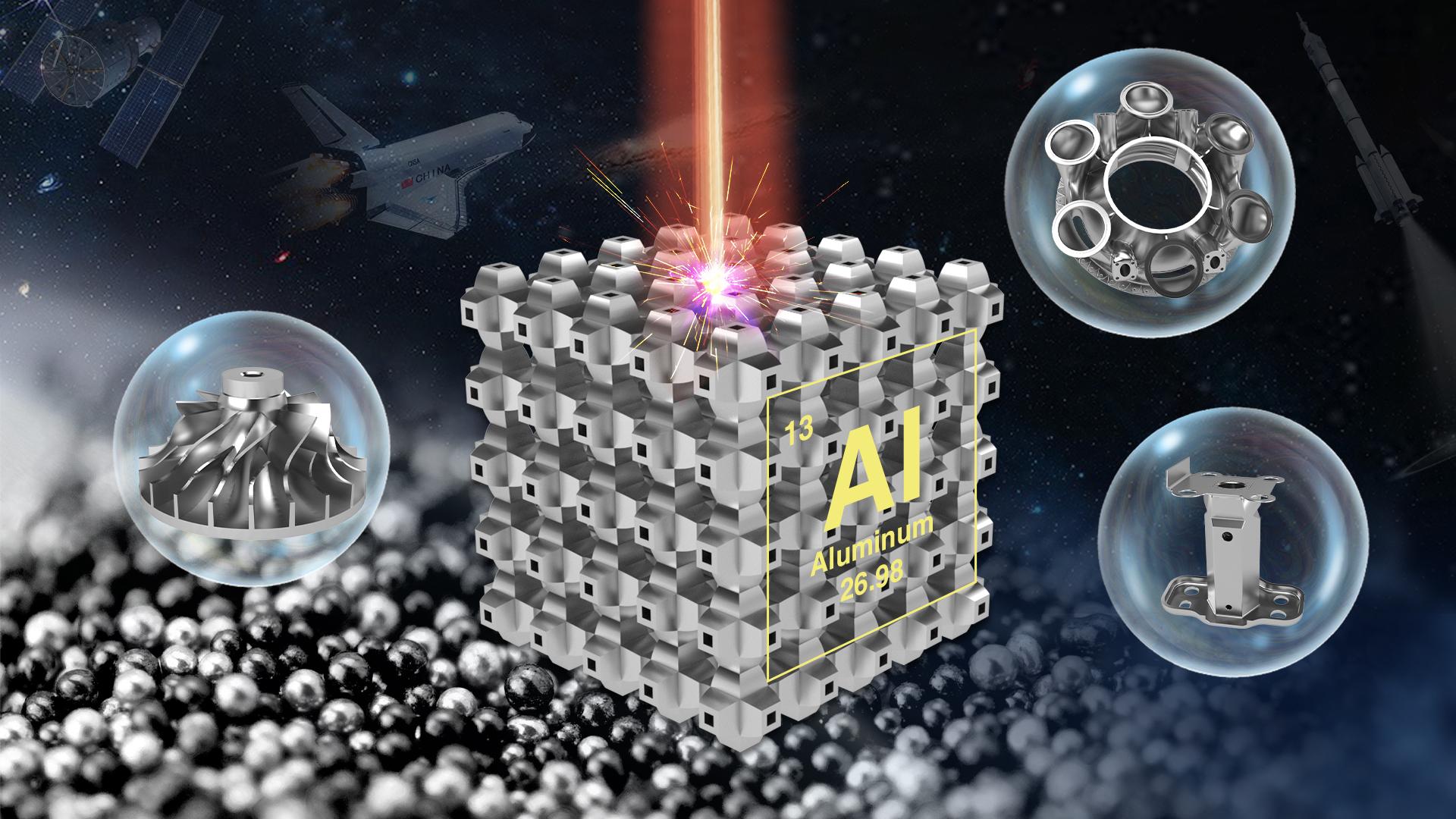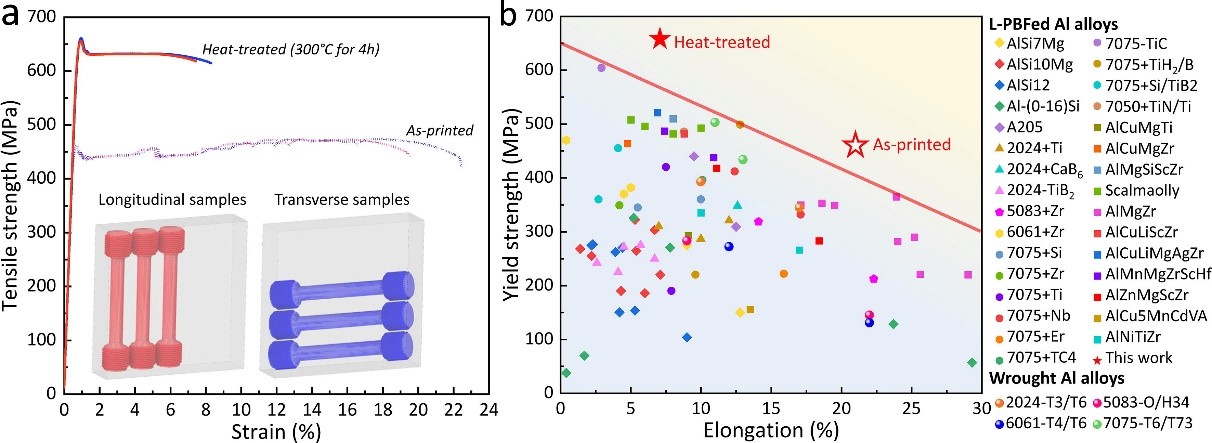Laser powder bed fusion, as a typical metal additive manufacturing technique, is now driving innovation in a myriad of sectors due to its unique ability to achieve the rapid fabrication of metallic parts with tremendous geometrical freedom. Against the backdrop of “carbon peaking and carbon neutrality” and the accelerated development of new quality productivity strategies, there is an increasing demand and higher standards for lightweight, high-strength, and high-toughness products in the market. Consequently, complex structural components of lightweight aluminum alloys with excellent mechanical properties have attracted widespread attention in the aerospace, automotive, and defense industries.
Most aluminum alloys in metal additive manufacturing are limited to near-eutectic compositions, such as AlSi10Mg. Although these compositions are easy to process, their mechanical properties often fail to meet higher requirements. On the other hand, precipitation-hardened aluminum alloys with optimal performance (such as the 2xxx or 7xxx series) have a wide solidification temperature range, making them prone to hot cracking under extreme solidification conditions during the printing process, thereby complicating their fabrication.

Chair Professor Qiang Zhu’s team from the Department of Mechanical and Energy Engineering at the Southern University of Science and Technology (SUSTech), in collaboration with the teams of Professor Jian Lu from the City University of Hong Kong (CityU), Professor Xinping Mao from the University of Science and Technology Beijing (USTB), and Professor Mingxing Zhang from the University of Queensland, Australia, have achieved new advancements in the field of additive manufacturing of high-strength aluminum alloys.
Their findings, entitled “Additively manufactured fine-grained ultrahigh-strength bulk aluminum alloys with nanostructured strengthening defects”, have been published in the top-tier international journal Materials Today.
This investigation demonstrates that the additive manufacturing technology using laser powder bed fusion (L-PBF) can induce aluminum alloys to possess both refined multimodal grain heterostructures and nanostructured 2D defects (such as stacking faults, twin boundaries, and 9R phases), thereby optimizing the material’s mechanical properties. The yield strength achieved (656 MPa) is among the highest levels reported for aluminum alloys produced by L-PBF to date while maintaining a significant elongation (~7.2%). The successful development of such high-strength and ductility aluminum alloys establishes a new paradigm for high-performance aluminum alloy components used in advanced structures, promoting lightweight design and reducing carbon footprints.
Previous studies by Qiang Zhu’s group and other teams have demonstrated that significant grain refinement and crack elimination can be induced during the printing process by in-situ formation or external introduction of heterogeneous nucleating particles that match the aluminum matrix lattice and/or solutes with a high-growth restriction factor (high Q values). However, achieving a satisfactory balance between strength and ductility remains challenging for these aluminum alloys, posing obstacles to their broader commercial deployment and industrial application in the additive manufacturing of aluminum alloys.
Recently, breakthroughs in the development of high-performance metallic materials in the materials science community have revealed the transformative potential of introducing nanoscale strengthening defects (such as twin boundaries, stacking faults, and 9R phases) to enhance mechanical properties. Nanocrystalline twins, for instance, as a distinctive microstructure, have long been a focal point of research within the industry due to their ability to impart exceptional properties like high strength and stability to metal materials. However, much of the related research to date has been confined to metals with moderate to low stacking fault energies, such as copper alloys, specialty steels, and some superalloys.
It has proven challenging to form nanocrystalline twin structures in metals with high stacking fault energies, such as aluminum, which are widely used in industry. For aluminum and its alloys, widespread adoption of these nanoscale defects for strengthening could significantly enhance their strength and thereby broaden their application range. Typically, combining high-stacking fault energy aluminum with other metals of low-stacking fault energy, such as silver or magnesium, can enable the formation of nanocrystalline aluminum-based films under conditions of ultra-rapid solidification (e.g., physical vapor deposition). This fabrication method is complex and demanding, requiring the use of low stacking fault energy metals as twin sources to induce twin growth and resulting only in film materials.
For the bulk materials with high stacking fault energy, current methods primarily rely on severe plastic deformation to introduce these nanoscale defects for strengthening, which limits their practical applications. Therefore, the challenge remains in developing a simpler method to directly prepare bulk aluminum materials with nanoscale 2D defect strengthening. Such research holds significant theoretical significance and practical value.
In response to the above issues, the collaborative team proposed a method using additive manufacturing technology to fabricate Al-Mg-Mn-Sc-Zr alloy materials with ultrafine heterogeneous structures and 2D nanoscale defect strengthening. These alloys exhibit both ultra-high strength and high ductility (i.e. high toughness). The results indicated that as-printed aluminum alloys displayed a stratified heterogeneous structure with three modes of grain distribution: ultrafine equiaxed grains, fine equiaxed grains, and fine columnar grains, primarily due to heterogeneous distribution of Al3(Sc,Zr) particles.
Further microscopic characterization revealed nanoscale 2D defects, including high-density stacking faults, twin boundaries, and 9R phases. The as-printed alloys demonstrated excellent mechanical properties: a yield strength of approximately 461 MPa and an elongation of about 21%. To further enhance precipitation strengthening effects, direct aging heat treatment (4 hours at 300 degrees Celsius) was employed to promote the precipitation of a large quantity of nanoscale strengthening precipitates.
Simultaneously, the nanoscale 2D defects and the stratified heterogeneous grain structure in the as-printed microstructure were preserved after heat treatment, achieving a combination of ultra-high strength and good ductility. The yield strength of the heat-treated alloy reached approximately 656 MPa with elongation of ~7.2%, surpassing that of nearly all previously reported additive-manufactured high-strength aluminum alloys and wrought aluminum alloys.

Figure 1. Hierarchical heterogeneous microstructure of the as-printed aluminum alloys

Figure 2. Microstructure of the nano-scaled 2D defects in the as-printed aluminum alloys

Figure 3. Mechanical properties of the L-PBFed aluminum alloys
Gan Li, a Ph.D. candidate at SUSTech, is the first author of the paper. Chair Professor Qiang Zhu, Professor Jian Lu, Professor Mingxing Zhang, and Lecturer Yuhe Huang (part of Professor Xinping Mao’s research team) from USTB, are the co-corresponding authors. Other contributions of this work included Associate Professor Wenjun Lu from the Department of Mechanical and Energy Engineering at SUSTech, Research Professor Xinggang Li from the Department of Materials Science and Engineering at SUSTech, Ph. D. candidate Junhua Hou from CityU, and master’s student Xi He from SUSTech.
This research was supported by the National Natural Science Foundation of China (NSFC), China Postdoctoral Science Foundation, Key Laboratory of High-Performance Materials Additive Manufacturing in Shenzhen, and the Shenzhen Basic Research Project.
Paper link: https://www.sciencedirect.com/science/article/pii/S1369702124000877
To read all stories about SUSTech science, subscribe to the monthly SUSTech Newsletter.
Proofread ByAdrian Cremin, Yingying XIA
Photo ByDepartment of Mechanical and Energy Engineering